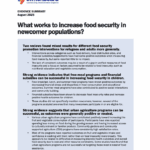Refugees remain vulnerable to acute food insecurity, malnutrition, and critically inadequate food and nutrient intake after migration, regardless of the economic level of the host country. We conducted this systematic review to summarize and evaluate the dietary intake and nutritional status among refugees resettled in non-camp settings worldwide. We searched PubMed and Web of Science databases to review relevant studies published between 2009 and 2020 using the Preferred Reporting Items for Systematic Reviews and Meta-Analyses (PRISMA) guidelines. We also conducted an additional manual search through PubMed and Google Scholar. Studies that evaluated both dietary intake and nutritional status of refugees in host countries were included. A total of 15 articles from 10 countries were included and assessed for study quality and outcomes. Poor dietary diversity and insufficient intake of specific food groups were reported. In addition to these dietary patterns, a high prevalence of stunting, underweight, and anemia was reported, particularly among children. A double burden of malnutrition was also observed across and within studies. Post-resettlement dietary intake and nutritional status of refugees are both influenced by factors at the pre- and post-resettlement stages as refugees transition to their host countries. Those factors, including pre-resettlement experiences, host country resources, socioeconomic status, acculturation, and food security, were summarized and presented in a conceptual model. There is a need for comprehensive dietary and health screening as well as culturally appropriate and sustainable nutrition education resources and interventions for refugees to improve their diet and nutrition. Longitudinal studies and novel methodological approaches are also suggested to measure changes in refugees’ food intake and nutritional status as well as to further investigate factors associated with these 2 components.
A Systematic Review on the Impact of Trauma-Informed Education Programs on Academic and Academic-Related Functioning for Students Who Have Experienced Childhood Adversity
The purpose of this study was to conduct a systematic review of the existing literature regarding trauma-informed education programs and their impact on academic and academic-related outcomes. The articles included for review (n=15) contained data on trauma-informed education programs implemented in preschool, primary/elementary, and high school settings. Academic and academic-related outcomes reported included attendance, disciplinary…

